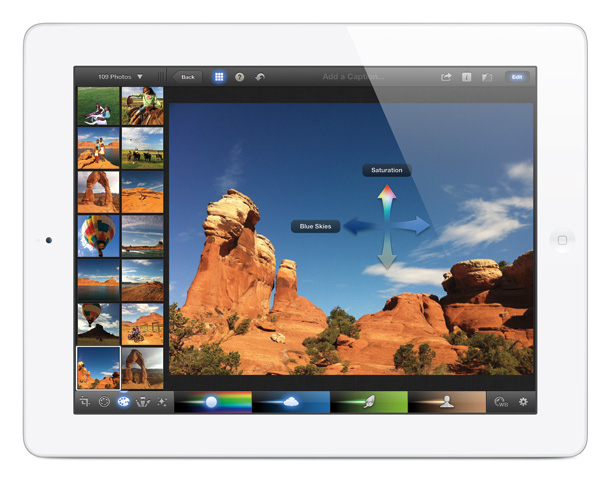Apple Hopes to Improve the Picture for the iPad

The iPad is getting a facelift as Apple tries to stay way ahead of the competition.
The third version of the tablet, which Apple CEO Tim Cook introduced Wednesday in San Francisco, will include a high-resolution “retina display” like the iPhone, as well as the ability to access high-speed LTE wireless networks. Other features include a more powerful processing chip called the A5X, an improved rear camera, and dictation capabilities.
The event marked the company’s first gadget unveiling since cofounder Steve Jobs died in October after a lengthy battle with pancreatic cancer. Cook and Apple’s marketing head, Phil Schiller, shared the duties of introducing the device.
Schiller said the new iPad will be available March 16, though orders can be placed now. Apple is keeping the price of the new version between $499 and $829, depending on its storage capacity and wireless capabilities, and it will lower the price of the most inexpensive iPad 2 to $399.
Though Apple was not the first to release a tablet computer, it was the first to make one that appealed to the masses. Apple sold 40.5 million iPads last year even as competitors flooded the market with rivals. Most have disappeared after making barely a ripple, with the exception of Amazon.com’s Kindle Fire, which, with a seven-inch display and $199 price tag, is smaller and cheaper than the iPad. According to a recent study from Forrester Research, Apple commands 73 percent of the tablet market, and no other brand controls more than 6 percent.
This huge lead is likely to continue with the release of Apple’s latest effort. The most significant change to the tablet is the display, which packs 264 pixels per inch into the 9.7-inch screen—making it twice as dense as the display on the iPad 2; the overall screen resolution is 2,048 by 1,536 pixels (compared with 1,024 by 768 on the iPad 2). Apple calls this screen a “retina display” because it says the pixels are so densely arranged that the human eye can’t distinguish between the individual pixels when the screen is held at a certain distance (with the iPhone, the distance is 10 inches or less; with the iPad, it’s 15 inches).
Schiller said the resulting display makes graphics and images crisper than before. He also said the new screen has greater color saturation than the one on the iPad 2, and as a result, images look richer and more detailed. “Everything you do is just going to look stunning—surfing the Web, reading your e-mails,” he said.
Bringing such a high-resolution screen to the iPad isn’t easy. DisplaySearch analyst Richard Shim says it requires making the pixels smaller to pack more of them in the same amount of space—which must be done without shrinking the portion of the pixel that allows color manipulation—while still pushing enough light through them to reach the iPad’s screen. It’s hard to make such displays without any messed-up pixels, so the larger the display, the more difficult it is to produce. Apple had to elevate some pixels onto a different plane in order to avoid crossed signals.
The iPad will be run by a beefier processor, called the A5X chip. The iPad also is getting a better rear camera, with a five-megapixel sensor and the ability to take high-definition videos in 1080p resolution. Some new video features include image stabilization and temporal noise reduction.
In addition, more expensive versions of the iPad will be able to surf the Web on LTE networks, which makes activities like downloading photos and streaming videos much speedier. In the U.S., AT&T and Verizon Wireless will provide LTE service for the new iPad in the United States. Pricing was not available Wednesday.
Schiller said the battery life will remain the same. However, the new iPad is a smidgen plumper than the iPad 2; it’s 0.37 inches thick and 1.4 pounds, compared with 0.34 inches and 1.3 pounds for its predecessor, though I was hard-pressed to notice a difference when I briefly tried a demonstration unit. Videos seemed to be crisper, but it was hard to tell without a side-by-side comparison, which Apple didn’t offer at Wednesday’s event. Of course, not all videos, including much of what you see online, will merit such a sharp display.
Keep Reading
Most Popular
Large language models can do jaw-dropping things. But nobody knows exactly why.
And that's a problem. Figuring it out is one of the biggest scientific puzzles of our time and a crucial step towards controlling more powerful future models.
The problem with plug-in hybrids? Their drivers.
Plug-in hybrids are often sold as a transition to EVs, but new data from Europe shows we’re still underestimating the emissions they produce.
Google DeepMind’s new generative model makes Super Mario–like games from scratch
Genie learns how to control games by watching hours and hours of video. It could help train next-gen robots too.
How scientists traced a mysterious covid case back to six toilets
When wastewater surveillance turns into a hunt for a single infected individual, the ethics get tricky.
Stay connected
Get the latest updates from
MIT Technology Review
Discover special offers, top stories, upcoming events, and more.